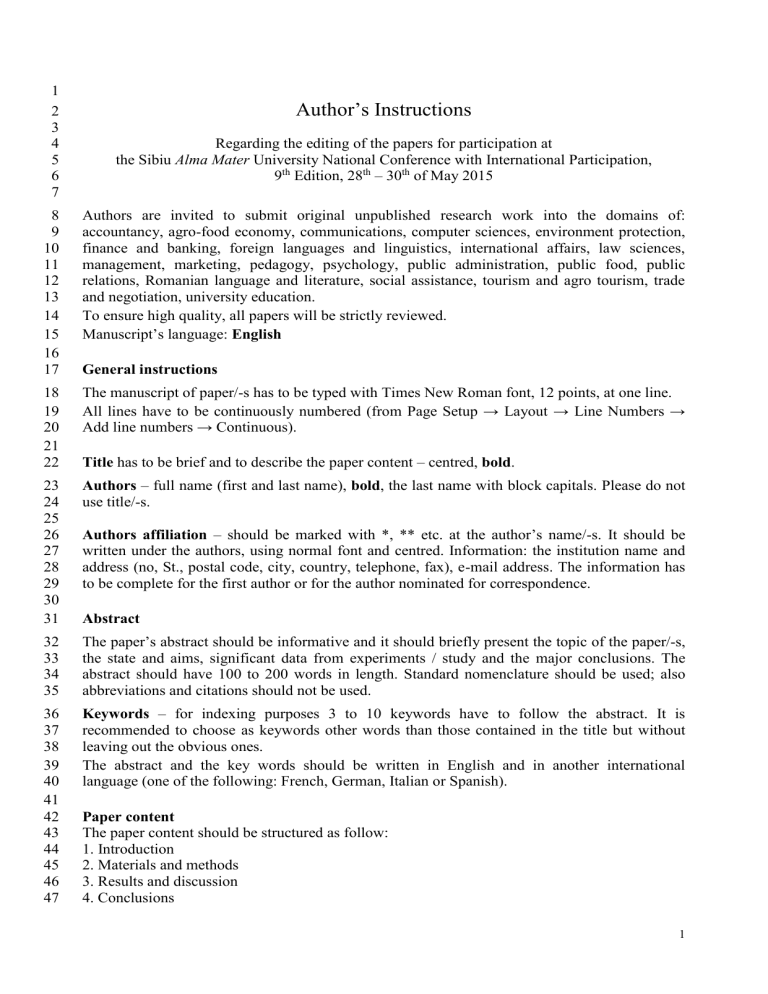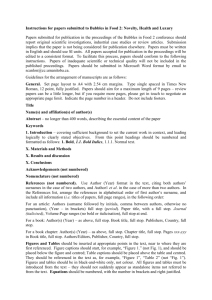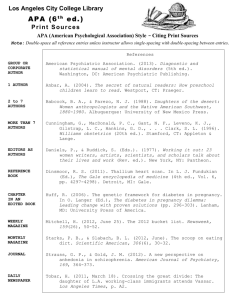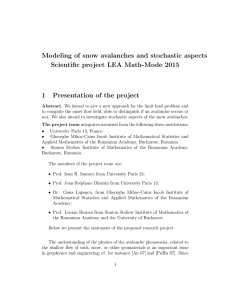Instrucţiuni pentru autori

18
19
20
21
22
23
24
25
26
27
28
29
30
31
36
37
38
39
40
41
42
43
44
45
46
47
32
33
34
35
1
5
6
7
2
3
4
8
9
10
11
12
13
14
15
16
17
Author’s Instructions
Regarding the editing of the papers for participation at the Sibiu Alma Mater University National Conference with International Participation,
9 th
Edition, 28 th
– 30 th
of May 2015
Authors are invited to submit original unpublished research work into the domains of: accountancy, agro-food economy, communications, computer sciences, environment protection, finance and banking, foreign languages and linguistics, international affairs, law sciences, management, marketing, pedagogy, psychology, public administration, public food, public relations, Romanian language and literature, social assistance, tourism and agro tourism, trade and negotiation, university education.
To ensure high quality, all papers will be strictly reviewed.
Manuscript’s language: English
General instructions
The manuscript of paper/-s has to be typed with Times New Roman font, 12 points, at one line.
All lines have to be continuously numbered (from Page Setup → Layout → Line Numbers →
Add line numbers → Continuous).
Title has to be brief and to describe the paper content – centred, bold .
Authors – full name (first and last name), bold , the last name with block capitals. Please do not use title/-s.
Authors affiliation – should be marked with *, ** etc. at the author’s name/-s. It should be written under the authors, using normal font and centred. Information: the institution name and address (no, St., postal code, city, country, telephone, fax), e-mail address. The information has to be complete for the first author or for the author nominated for correspondence.
Abstract
The paper’s abstract should be informative and it should briefly present the topic of the paper/-s, the state and aims, significant data from experiments / study and the major conclusions. The abstract should have 100 to 200 words in length. Standard nomenclature should be used; also abbreviations and citations should not be used.
Keywords – for indexing purposes 3 to 10 keywords have to follow the abstract. It is recommended to choose as keywords other words than those contained in the title but without leaving out the obvious ones.
The abstract and the key words should be written in English and in another international language (one of the following: French, German, Italian or Spanish).
Paper content
The paper content should be structured as follow:
1. Introduction
2. Materials and methods
3. Results and discussion
4. Conclusions
1
58
59
60
61
62
63
64
65
66
67
68
53
54
55
56
57
48
49
50
51
52
82
83
84
85
86
87
88
89
90
76
77
78
79
80
81
91
92
93
69
70
71
72
73
74
75
Acknowledgements (if it is necessary)
References
Abbreviations (if it is necessary)
Introduction
The introduction should provide a clear statement of the problem presented in the paper, the citation of relevant literature and the study objectives. The introduction should be understandable to colleagues from a broad range of scientific domains.
Materials and methods (for experimental works, case studies etc.)
Materials and methods should be complete enough to allow experiments / case studies to be reproduced. Trade names and manufacturer’s name have to be indicated. Known methods have only to be mentioned and sources cited. Also, only genuinely new procedures designed by authors and important changes should be shortly described and/or presented. When values are used, the metric units and the International System of measurement units have to be followed.
Results and discussion
The results have to be presented clearly and precisely. They should be written in the past tense and the previously published data should be written in the present tense following the right citations. The results should be explained, analysed and discussed to allow the partial and final conclusions statement.
The Results and discussion chapter may include subheadings, named and numbered accordingly.
Conclusions
The conclusions should be stated in few sentences at the end of the paper. It is recommended that they should not be a reproduction of the abstract’s final part.
Acknowledgements
The financial support of the research/study – programme, grant, fellowship – should be indicated.
Acknowledgements should be addressed (if it is the case) to significant contributors, but not authors, to a laboratory / institution which allowed the experiments etc.
Tables
The tables should be introduced after the fist citation. Their use should be kept to minimum and be designed as simple as possible, edited in Word directly into the paper, not imported from elsewhere.
The tables should be numbered with Arabic numerals. The number should be followed by a brief description of the content, no more than two lines, at the head of the table. Each column should have a heading and the corresponding measurement unit. Supplementary descriptions should be added at the bottom of the table, if necessary.
Figures
The figures should be introduced after the fist citation. It is recommended to use the same font as in the paper for figures editing. The figures have to be clear, and the points presenting the data should be well emphasized.
2
120
121
122
123
124
125
126
127
128
129
130
131
132
133
134
135
136
137
138
100
101
102
103
104
105
106
107
108
109
110
111
112
113
114
115
116
117
118
119
94
95
96
97
98
99
The figures should be numbered with Arabic numerals, followed by a short description, both below the figure. They should be accompanied by a legend with explanations (point’s symbols, series symbols etc.).
Unsatisfactory figures will be returned to authors for revision.
Photographs should be clear and have good quality prints or high contrasts.
Figures, both graphics and photographs, should be prepared black and white for printing.
The same data should not be presented in both table and graph form or repeated in the text to avoid papers of being disqualified.
References
The list of references should be presented alphabetically, by the first author and without numbering. All the references have to be cited in the paper.
Up-to-dateness references are recommended.
When more citations of the same first author are used, the arrangement is done by the publication’s year. If there are more citations of the same author and the same year, the notation a, b etc. should be used.
Abbreviation of journal titles will follow the international standards.
Examples:
Ionescu, M. 2008. Name of book , Publisher, Place of publication.
Ionescu, P. and Smith, M.F. 2005. Name of chapter , in Name of book , (editors), Publisher, Place of publication, page numbers.
Popescu, L. and Ion, V. 2001. Name of paper. Name of journal , vol . (no), page numbers.
Morris, H., Smith, M.F., Bush, D.L. and Black, R. 2007. Name of paper. In: Name of book / volume (Editors), Publisher, Place of publication, page numbers.
Albu, I. 2003a. Name of paper. Name of journal , vol. (no), page numbers.
Albu, I. 2003b. Name of paper. Name of journal , vol. (no), page numbers.
The references should be written in its original language (the title should be translated in
English).
In the text, references to other work should take the form: (Ionescu and Smith, 2004), (Morris et al ., 2007), (Albu, 2003a), (Ionescu, 2008; Albu, 2003b) or: ”Researches done by Ionescu (2004) demonstrate that ...”, ”... comparing to data published by Ionescu and Smith (2005) ...” etc.
Abbreviations
Not usually needed; can be added if necessary.
Footnotes
The editors encourage the authors to minimise the use of footnotes.
Footnotes should be indicated in the text by the following symbols: + (dagger), ‡ (double dagger), ║ (parallels), # (number sign).
Footnotes for a reference used many times in the text are accepted, in that way pages, chapters etc. of interest could be stated.
Appendix
Not usually needed; can be added if necessary.
3








